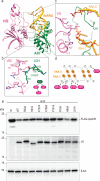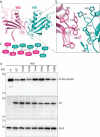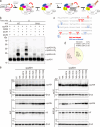HIV-1 vif mediates ubiquitination of the proximal protomer in the APOBEC3H dimer to induce degradation
- PMID: 40593686
- PMCID: PMC12217271
- DOI: 10.1038/s41467-025-60984-y
HIV-1 vif mediates ubiquitination of the proximal protomer in the APOBEC3H dimer to induce degradation
Abstract
The APOBEC3 family of cytidine deaminases restricts retroviruses like HIV-1 by mutating viral DNA. HIV-1 evades this restriction by producing Vif, which recruits the Cullin-5 (CUL5) E3 ubiquitin ligase complex to promote APOBEC3 degradation. Here we resolve key aspects of this counter-defense mechanism by determining a 3.6 Å cryo-EM structure of chimpanzee APOBEC3H (cpzA3H) in complex with HIV-1 Vif and three components of the CUL5 E3 ligase-CBFβ, EloB, and EloC (VCBC). The structure captures cpzA3H as an RNA-mediated dimer within the cpzA3H-VCBC complex, allowing us to examine the role of dimerization. We find that ubiquitination occurs specifically at two lysine residues on the Vif-proximal protomer, while the distal protomer remains unmodified. The structural model of the active cpzA3H-Vif-CUL5 E3 ligase holoenzyme reveals spatial preferences for ubiquitin transfer to the targeted lysine residues. These findings enhance our understanding of A3H degradation and suggest new antiviral strategies targeting this host-virus interface.
© 2025. This is a U.S. Government work and not under copyright protection in the US; foreign copyright protection may apply.
Conflict of interest statement
Competing interests: The authors declare no competing interests.
Figures








Similar articles
-
Core binding factor beta plays a critical role by facilitating the assembly of the Vif-cullin 5 E3 ubiquitin ligase.J Virol. 2014 Mar;88(6):3309-19. doi: 10.1128/JVI.03824-13. Epub 2014 Jan 3. J Virol. 2014. PMID: 24390320 Free PMC article.
-
Structural insights into PPP2R5A degradation by HIV-1 Vif.Nat Struct Mol Biol. 2024 Oct;31(10):1492-1501. doi: 10.1038/s41594-024-01314-6. Epub 2024 May 24. Nat Struct Mol Biol. 2024. PMID: 38789685 Free PMC article.
-
Identification of a Conserved Interface of Human Immunodeficiency Virus Type 1 and Feline Immunodeficiency Virus Vifs with Cullin 5.J Virol. 2018 Feb 26;92(6):e01697-17. doi: 10.1128/JVI.01697-17. Print 2018 Mar 15. J Virol. 2018. PMID: 29263270 Free PMC article.
-
The assembly of Vif ubiquitin E3 ligase for APOBEC3 degradation.Arch Pharm Res. 2015 Apr;38(4):435-45. doi: 10.1007/s12272-014-0519-x. Epub 2014 Nov 20. Arch Pharm Res. 2015. PMID: 25408426 Review.
-
Structural insights for HIV-1 therapeutic strategies targeting Vif.Trends Biochem Sci. 2014 Sep;39(9):373-80. doi: 10.1016/j.tibs.2014.07.001. Epub 2014 Aug 12. Trends Biochem Sci. 2014. PMID: 25124760 Free PMC article. Review.
References
-
- Sheehy, A. M., Gaddis, N. C., Choi, J. D. & Malim, M. H. Isolation of a human gene that inhibits HIV-1 infection and is suppressed by the viral Vif protein. Nature418, 646–650 (2002). - PubMed
-
- Harris, R. S. et al. DNA deamination mediates innate immunity to retroviral infection. Cell113, 803–809 (2003). - PubMed
-
- Mangeat, B. et al. Broad antiretroviral defence by human APOBEC3G through lethal editing of nascent reverse transcripts. Nature424, 99–103 (2003). - PubMed
-
- Mariani, R. et al. Species-specific exclusion of APOBEC3G from HIV-1 virions by Vif. Cell114, 21–31 (2003). - PubMed
MeSH terms
Substances
Grants and funding
- R01 AI150478/AI/NIAID NIH HHS/United States
- ZIA BC011627/ImNIH/Intramural NIH HHS/United States
- JP17fk0410304/Japan Agency for Medical Research and Development (AMED)
- JP23fk0410058h0001/Japan Agency for Medical Research and Development (AMED)
- R01AI150478/U.S. Department of Health & Human Services | NIH | Office of Extramural Research, National Institutes of Health (OER)
LinkOut - more resources
Full Text Sources

